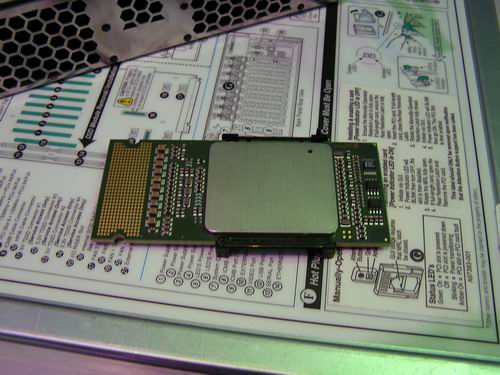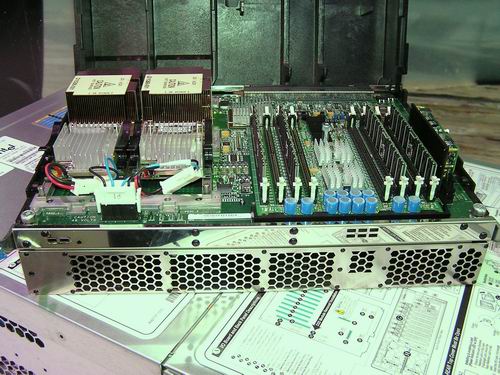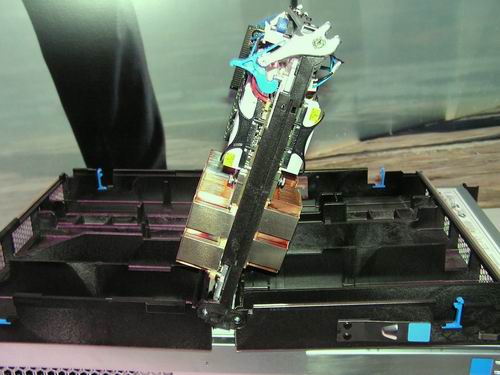Cebit 2006: High end Motherboards and Server News
by Johan De Gelas on March 13, 2006 12:05 AM EST- Posted in
- Trade Shows
Itanium ready to take on the RISC competition
Most of the press seemed to have given the Itanium family an early burial. “Itanic” would die out, but this perception might change quickly.
Intel cited an IDC report, which reported that the Itanium already achieves 30% of the revenue of the IBM RISC space, and 48% of Sun’s RISC revenue. Considering that the single threaded “Madison” (1.6 GHz, 3-9 MB L3-cache) is hardly interesting for servers compared to the quad (and much more) threaded IBM Power family, it is quite an achievement. Itanium must be quite a success in the HPC space, a market which is about 6 billion dollars worth.
A completely new and ambitious Engineering team in Colorado is up and running and will help develop the future generation of Itanium.
Montecito was on display on Cebit, but besides a few vague benchmarks, little performance data was available.
Most of the press seemed to have given the Itanium family an early burial. “Itanic” would die out, but this perception might change quickly.
Intel cited an IDC report, which reported that the Itanium already achieves 30% of the revenue of the IBM RISC space, and 48% of Sun’s RISC revenue. Considering that the single threaded “Madison” (1.6 GHz, 3-9 MB L3-cache) is hardly interesting for servers compared to the quad (and much more) threaded IBM Power family, it is quite an achievement. Itanium must be quite a success in the HPC space, a market which is about 6 billion dollars worth.
A completely new and ambitious Engineering team in Colorado is up and running and will help develop the future generation of Itanium.
Montecito was on display on Cebit, but besides a few vague benchmarks, little performance data was available.













19 Comments
View All Comments
AkaiRo - Monday, March 13, 2006 - link
When you talk about SAS you have to clarify if you are referring to SAS 3.5" or SAS SFF (Small Form Factor). SAS 3.5", which is what the companies you are talking about in the article are using, is only a waypoint on the roadmap. SAS 3.5" and low-end/mid-range SATA enclosures use U320 connectors. High End SATA enclosures can use fibre or RJ-45 connectors as well. However, there are SAS (and SATA) SFF enclosures out on the market already (HP's Modular Storage Array 50 enclosure).SAS/SATA SFF is the designated target for the majority of storage subsystems in the next few years because server manufacturers are going to increasing focus more on spindle count affecting overall I/O than anything else. The SAS SFF drives use the platters from the 15,000rpm drives which are 2.5" in size, which is why the largest SAS SFF drives for now are 146GB. There is quite an initiative by the biggest players who deal in servers, workstations/desktops, AND notebooks, to move to a common platform for ALL three classes of machines, but it's a chicken and egg thing with everyone waiting for someone else to provide the incentive to make the switch.
Calin - Tuesday, March 14, 2006 - link
The 2.5 inch drives are physically too small to reach high capacities, and many of the buyers don't know anything about the hard drive they have except capacity. As a result, a physically smaller, less warm, even supposedly higher performance drive at a higher price will be at disadvantage compared to a physically larger, warmer and even lower performance at a lower price. Especially taking into account that you can buy 500GB 3.5inch drives, but only 120GB 2.5inch drivesthemelon - Monday, March 13, 2006 - link
This is nothing new. Granted once you go beyond 4 you have to run them slower....JohanAnandtech - Tuesday, March 14, 2006 - link
8 Dimms per CPU was very uncommon and required expensive components and engineering. I have seen on the HP DL585, but there 8 DIMMs result in DDR266 speed, which is serious performance penalty. Most DDR boards are still limited to 4 DIMMs per CPU.With DDR-2 6 - 8 DIMMs per CPU is relatively easy to do, at least at DDR-II 667 speeds. You'll see 6-8 DIMMs also on affordable solutions, not on high eend server only. That is new :-)
Beenthere - Monday, March 13, 2006 - link
SAS don't impress me none at this stage. Yes it's more reliable than SATA drives but almost anything is. Drive performance is virtually identical with SAS and SCSI 320. All I see is a lower manufacturing cost that hasn't been passed on yet.ncage - Monday, March 13, 2006 - link
Improving performance is not the whole point of SAS. SCSI 320 is already fast as it is. Heck SCSI 160 is fast. Anyawys i digress. Its the ability to use SATA cables in a server which is a big deal when your dealing with a little 1U case. Its also the ability to Mix/Match SATA with SCSI with for some data centers could dramtically save money. If you mixed SATA/SCSI you could have a combination of Peformance/Redudancy/Cost all in one package. Granted "Critical" data centers will probably be all SCSI. I wouldn't advise eBay put SATA drivers on their servers :). You can't expect each reviesion of storage connection technology to provide better performance...sometimes it not about peformance at all.Calin - Tuesday, March 14, 2006 - link
There are enough servers that don't need hard drive performance, and will run anything mirrored in RAM. As a result, one could use the same boxes, only with different hard drives for different tasks. Makes everything simpler if you have a single basic box.dougSF30 - Monday, March 13, 2006 - link
Rev E DC Opteron TDPs have also always been 95W. The SC Rev E parts were 89W.http://www.amdcompare.com/us%2Den/opteron/Default....">http://www.amdcompare.com/us%2Den/opteron/Default....
You can look up the Rev E Opteron parts at the above link.
dougSF30 - Monday, March 13, 2006 - link
These are likely not the parts you see at 68W with Rev F, so again, power is not rising (it is actually falling with Rev F).There has been a 68W "blade TDP" point that Rev E Opterons have been sold at, in addition to the 55W and 30W points.
So, I suspect you are simply seeing 95W and 68W TDP families for Rev F, just like Rev E. Rev F will allow for higher frequency parts within those families, in part due to a DDR2 controller taking less power than DDR1, in part due to SiGe strain being incorporated into the 90nm process.